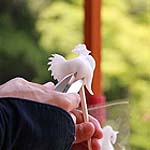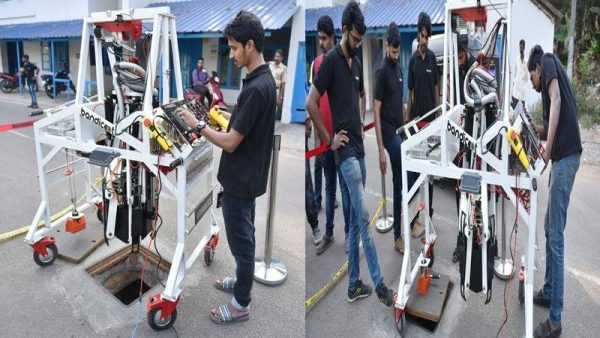
A sculpture you can eat!
Lost in oblivion, Amezaiku is a Japanese art of making CANDY sculptures. There are only few people left in Japan, who practice this art-form and spread knowledge about it. A.Kameshwari from One World News was fortunate enough to catch up with Takahiro Mizuki, a candy sculptor, in a conversation, to know more about this art-form.
Practicing Amezaiku since thirteen years, Takahiro Mizuki makes a candy sculpture in mere 3 minutes! The process has to be very quick while the mixture is hot because if the mixture gets harder then sculpting the candy gets hard and to eat as well. Let us know his journey of Amezaiku:

Takahiro Mizuki demonstrating the art of Amezaiku
How did you come to learn this art?
When I witnessed Amezaiku for the very first time, I was fascinated and very much interested to know about it. I even watched it for five hours straight, and I just couldn’t help thinking about trying it myself.
Since how long have you been practicing this art-form?
It’s been thirteen years now. I was in mid-twenties, when I came across the art of candy sculpting. It was surprising for me to know about something, which has been a part of Japan’s tradition but in spite of being born and brought up in Japan, I had no idea about it.

An old painting showing Amezaiku tradition
In an era of technology, where making candy has become so easy, why do you still prefer to make candies with hands?
That is the point. Amezaiku is totally different from other candy making processes such as, mass production in a factory. People can easily know it once I show them my candy sculpting. It won’t take a long time because I can finish one piece in only three minutes or so. The attraction of Amezaiku is, that it is not just a candy making technique but an entertainment in itself! People enjoy watching me to sculpt candies into a variety of shapes such as a bird, a dolphin, and many other animals one after another in a very short time. I have to be quick because hot candy gets cooler and harder second by second. The process and shapes are so fine and complicated that any machinery can never do the same. Amezaiku is a work of a man’s hand.
How has been your journey so far?
I think I was very lucky to have known Amezaiku. It needs fine work by hands and it is something what I am good at. To me it is important that I can feel that I am improving my technique year by year. The more I improve, the more I can entertain people. It is the smile and the surprises that I see on face that give me the joy of practicing it. I have a lot of ideas for sculpting and still have a long way to go.

Takahiro Mizuki making cock-candy
Which has been your most selling candy sculpture? Tell us something more about it?
If all shapes sold at the same price, most selling shape would be a dragon. But the price differs depending on the difficulties to sculpt. And a dragon is one of the most difficult shapes to sculpt so its price is relatively expensive. I can even make a gorgeous version of a dragon in colored or tri-colored candy. They are one of the most expensive and at the same time, the most fragile shape, unfortunately!
Amezaiku has been abandoned because it is considered unhygienic, so what is it that has kept you practicing?
I think Amezaiku is very unique because it has some aspects in terms of entertainment, art, and delicacy at the same time. Nowadays Amezaiku is considered more to be an entertainment. Mostly, I perform at festivals, birthday parties, weddings, and so on. And Amezaiku is something rare for people to see. The way people get amused about this art is just like I was a decade ago, I assume. I couldn’t understand, why such an interesting art form was disappearing. I want to share my feelings of the experience, when I first met Amezaiku and that is probably why I keep practicing.

Takahiro Mizuki making dragon-candy
Which has been your most recent design?
My most recent design is a Tengu. It’s an imaginary creature, which is common in Japan. I made it in a different way from the one I used to. I usually sculpt an animal from one candy ball only. But a Tengu is made from several parts. I am planning to show it at a performance in Abu Dhabi, U.A.E. a month later.
How difficult was it for you to make sculptures in the beginning?
First of all, heated candy is very hot to handle. I used to get my fingers burnt in early days. I have to pull the candy in order to make it whiter or colored. Making a candy ball at the top of a chopstick, it is the first hard step. I have to be quick all the time, so that I can keep the candy warm enough, to start sculpting.

Takahiro Mizuki demonstrating the art of Amezaiku
As it is now erasing from memory of people in Japan and around the world, what measure you are planning to take or already taken to keep it alive?
It is true that the number of practitioners is much less now but I believe that Amezaiku does not disappear. I can say it because I am the one, who was attracted and became a practitioner. That means I am going to have to be a really good one, enough good to make someone else also get attracted! I will try surely. I also have a website (amezaiku.com) in three languages- Japanese, French and English. People can contact me through the internet. I will fly anywhere in the world to show my Amezaiku.
What is the trick behind holding the hot mixture of sugar?
I thought there should be a trick but there was NOT. There is no shortcut to success!
What all flavors are available and how do you make them?
There is only one flavor. It’s a natural flavor of candy material itself. It’s sweet but not very.

Takahiro Mizuki demonstrating the art of Amezaiku
When you prepare these delicacies, what is more important for you- taste, color or a combination of both?
In fact, the most important thing, when preparing these delicacies, is thickness of the candy. I have to prepare the right candy according to the temperature at the venue. The bigger matter is to not let the candy get rigid too fast, or too slow than taste and color.
What has been public’s response to your candies and this art form?
People enjoy watching Amezaiku regardless of age or nationality. Japanese people know Amezaiku by name only most people have never really seen it. The elders go back to their childhood memories of ancient Amezaiku with a nostalgic smile.
Kids are happy because it’s made of candy. Foreigners, candy sculpting seems to be something magical. One day, during a show abroad, I felt honored, when I heard someone saying that my show was as crowded as a F-1 car at the site. I often see that initially people look quizzically, then surprisingly and finally, admiringly, that’s when I feel fortunate!

Candies made by Takahiro
How does it feel seeing people eat your sculptures, is it heart-breaking?
No, it is not heart-breaking at all. Especially for kids, a candy is a candy nonetheless! I sometimes don’t feel like selling a very well-sculpted piece and I would rather keep it for myself. I am a practitioner and at the same time I am a fan of Amezaiku.
What is the average shelf-life of a candy sculpture?
It will be two or three weeks depending on temperature and humidity.
How do you take care of packaging of candy sculptures?
I usually use plastic bags.
Kudos to Takahiro Mizuki for keeping such a beautiful art form still alive; it takes courage to be creative and to be able to take this creativity life-long with you. It is entirely our responsibility to encourage such unique art-forms and spread its knowledge all around, so that the legacy of the art doesn’t get over and the next generation gets the opportunity to witness such art-form.
Have a news story, an interesting write-up or simply a suggestion? Write to us at
info@oneworldnews.com







